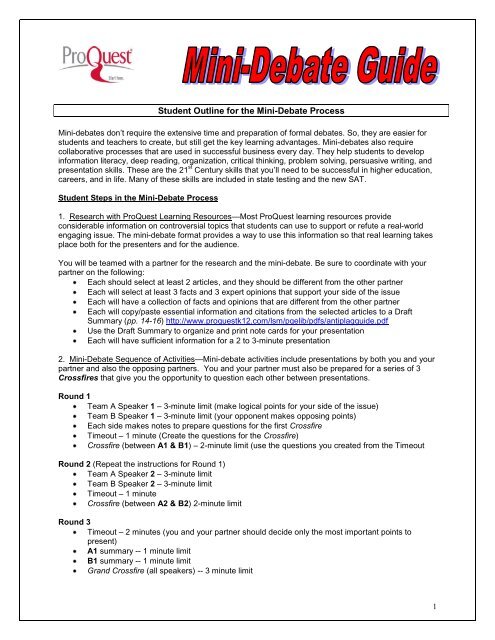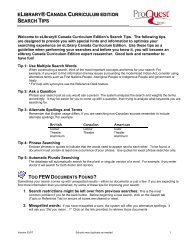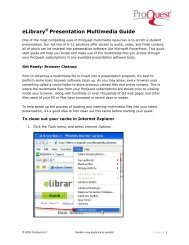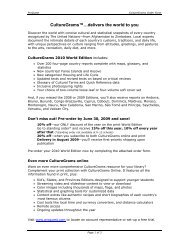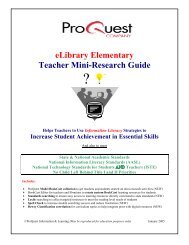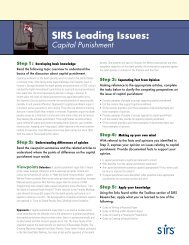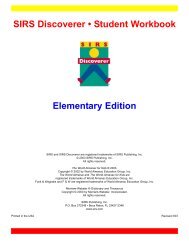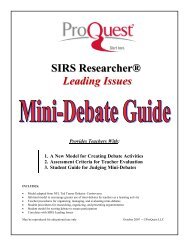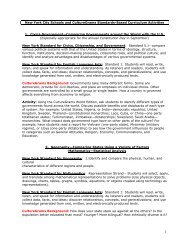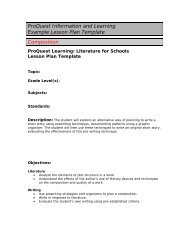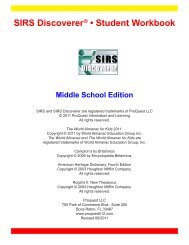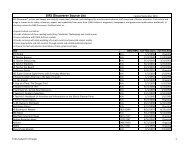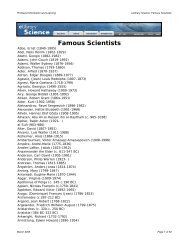Student Outline for the Mini-Debate Process - ProQuest
Student Outline for the Mini-Debate Process - ProQuest
Student Outline for the Mini-Debate Process - ProQuest
You also want an ePaper? Increase the reach of your titles
YUMPU automatically turns print PDFs into web optimized ePapers that Google loves.
<strong>Student</strong> <strong>Outline</strong> <strong>for</strong> <strong>the</strong> <strong>Mini</strong>-<strong>Debate</strong> <strong>Process</strong><br />
<strong>Mini</strong>-debates don’t require <strong>the</strong> extensive time and preparation of <strong>for</strong>mal debates. So, <strong>the</strong>y are easier <strong>for</strong><br />
students and teachers to create, but still get <strong>the</strong> key learning advantages. <strong>Mini</strong>-debates also require<br />
collaborative processes that are used in successful business every day. They help students to develop<br />
in<strong>for</strong>mation literacy, deep reading, organization, critical thinking, problem solving, persuasive writing, and<br />
presentation skills. These are <strong>the</strong> 21 st Century skills that you’ll need to be successful in higher education,<br />
careers, and in life. Many of <strong>the</strong>se skills are included in state testing and <strong>the</strong> new SAT.<br />
<strong>Student</strong> Steps in <strong>the</strong> <strong>Mini</strong>-<strong>Debate</strong> <strong>Process</strong><br />
1. Research with <strong>ProQuest</strong> Learning Resources—Most <strong>ProQuest</strong> learning resources provide<br />
considerable in<strong>for</strong>mation on controversial topics that students can use to support or refute a real-world<br />
engaging issue. The mini-debate <strong>for</strong>mat provides a way to use this in<strong>for</strong>mation so that real learning takes<br />
place both <strong>for</strong> <strong>the</strong> presenters and <strong>for</strong> <strong>the</strong> audience.<br />
You will be teamed with a partner <strong>for</strong> <strong>the</strong> research and <strong>the</strong> mini-debate. Be sure to coordinate with your<br />
partner on <strong>the</strong> following:<br />
Each should select at least 2 articles, and <strong>the</strong>y should be different from <strong>the</strong> o<strong>the</strong>r partner<br />
Each will select at least 3 facts and 3 expert opinions that support your side of <strong>the</strong> issue<br />
Each will have a collection of facts and opinions that are different from <strong>the</strong> o<strong>the</strong>r partner<br />
Each will copy/paste essential in<strong>for</strong>mation and citations from <strong>the</strong> selected articles to a Draft<br />
Summary (pp. 14-16) http://www.proquestk12.com/lsm/pqelib/pdfs/antiplagguide.pdf<br />
Use <strong>the</strong> Draft Summary to organize and print note cards <strong>for</strong> your presentation<br />
Each will have sufficient in<strong>for</strong>mation <strong>for</strong> a 2 to 3-minute presentation<br />
2. <strong>Mini</strong>-<strong>Debate</strong> Sequence of Activities—<strong>Mini</strong>-debate activities include presentations by both you and your<br />
partner and also <strong>the</strong> opposing partners. You and your partner must also be prepared <strong>for</strong> a series of 3<br />
Crossfires that give you <strong>the</strong> opportunity to question each o<strong>the</strong>r between presentations.<br />
Round 1<br />
Team A Speaker 1 – 3-minute limit (make logical points <strong>for</strong> your side of <strong>the</strong> issue)<br />
Team B Speaker 1 – 3-minute limit (your opponent makes opposing points)<br />
Each side makes notes to prepare questions <strong>for</strong> <strong>the</strong> first Crossfire<br />
Timeout – 1 minute (Create <strong>the</strong> questions <strong>for</strong> <strong>the</strong> Crossfire)<br />
Crossfire (between A1 & B1) – 2-minute limit (use <strong>the</strong> questions you created from <strong>the</strong> Timeout<br />
Round 2 (Repeat <strong>the</strong> instructions <strong>for</strong> Round 1)<br />
Team A Speaker 2 – 3-minute limit<br />
Team B Speaker 2 – 3-minute limit<br />
Timeout – 1 minute<br />
Crossfire (between A2 & B2) 2-minute limit<br />
Round 3<br />
Timeout – 2 minutes (you and your partner should decide only <strong>the</strong> most important points to<br />
present)<br />
A1 summary -- 1 minute limit<br />
B1 summary -- 1 minute limit<br />
Grand Crossfire (all speakers) -- 3 minute limit<br />
1
Round 4<br />
Timeout – 2 minutes (you and your partner should decide on <strong>the</strong> most important point <strong>for</strong> your<br />
side and any glaring weakness in your opponents’ arguments)<br />
A2 Last Shot -- 1 minute limit<br />
B2 Last Shot -- 1 minute limit<br />
3. Evaluating <strong>the</strong> <strong>Mini</strong>-<strong>Debate</strong>—There will be both a teacher and a student evaluation of each minidebate.<br />
The teacher evaluation includes all <strong>the</strong> student work involved in <strong>the</strong> mini-debate including <strong>the</strong><br />
research, organization, and presentation. Your teacher will share <strong>the</strong> criteria <strong>for</strong> this evaluation with you<br />
prior to <strong>the</strong> mini-debate assignment.<br />
Your fellow students will judge <strong>the</strong> winning side in <strong>the</strong> mini-debate. This does not necessarily affect your<br />
teacher evaluation. <strong>Student</strong>s like to keep score and it helps <strong>the</strong>m to be part of <strong>the</strong> activity. You will have<br />
your turn to do this when o<strong>the</strong>r mini-debates are scheduled. The scoring system that follows will be used<br />
by students to judge <strong>the</strong> winning side:<br />
<strong>Student</strong> Rubrics Model to Participate and Determine <strong>the</strong> <strong>Debate</strong> Winner<br />
<strong>Debate</strong> Activities Sequence Affirmative Score Negative Score<br />
Scoring (Convincing = 4; Satisfactory = 2; Little Impact = 1)<br />
Affirmative (Pro Issue) Speaker 1<br />
Negative (Con Issue) Speaker 1<br />
Crossfire <strong>for</strong> <strong>the</strong> Affirmative (Pro Issue)<br />
Crossfire <strong>for</strong> <strong>the</strong> Negative (Con Issue)<br />
Affirmative (Pro Issue) Speaker 2<br />
Negative (Con Issue) Speaker 2<br />
Crossfire <strong>for</strong> <strong>the</strong> Affirmative (Pro Issue)<br />
Crossfire <strong>for</strong> <strong>the</strong> Negative (Con Issue)<br />
Affirmative Speaker 1 (Pro Issue) Summary<br />
Negative Speaker 1 (Con Issue) Summary<br />
Grand Crossfire (all speakers) <strong>for</strong> <strong>the</strong> Affirmative (Pro)<br />
Grand Crossfire (all speakers) <strong>for</strong> <strong>the</strong> Negative (Con)<br />
Affirmative Speaker 2 (Pro Issue) Last Shot<br />
Negative Speaker 2 (Con Issue) Last Shot<br />
<strong>Student</strong> Evaluator:<br />
Totals<br />
2


